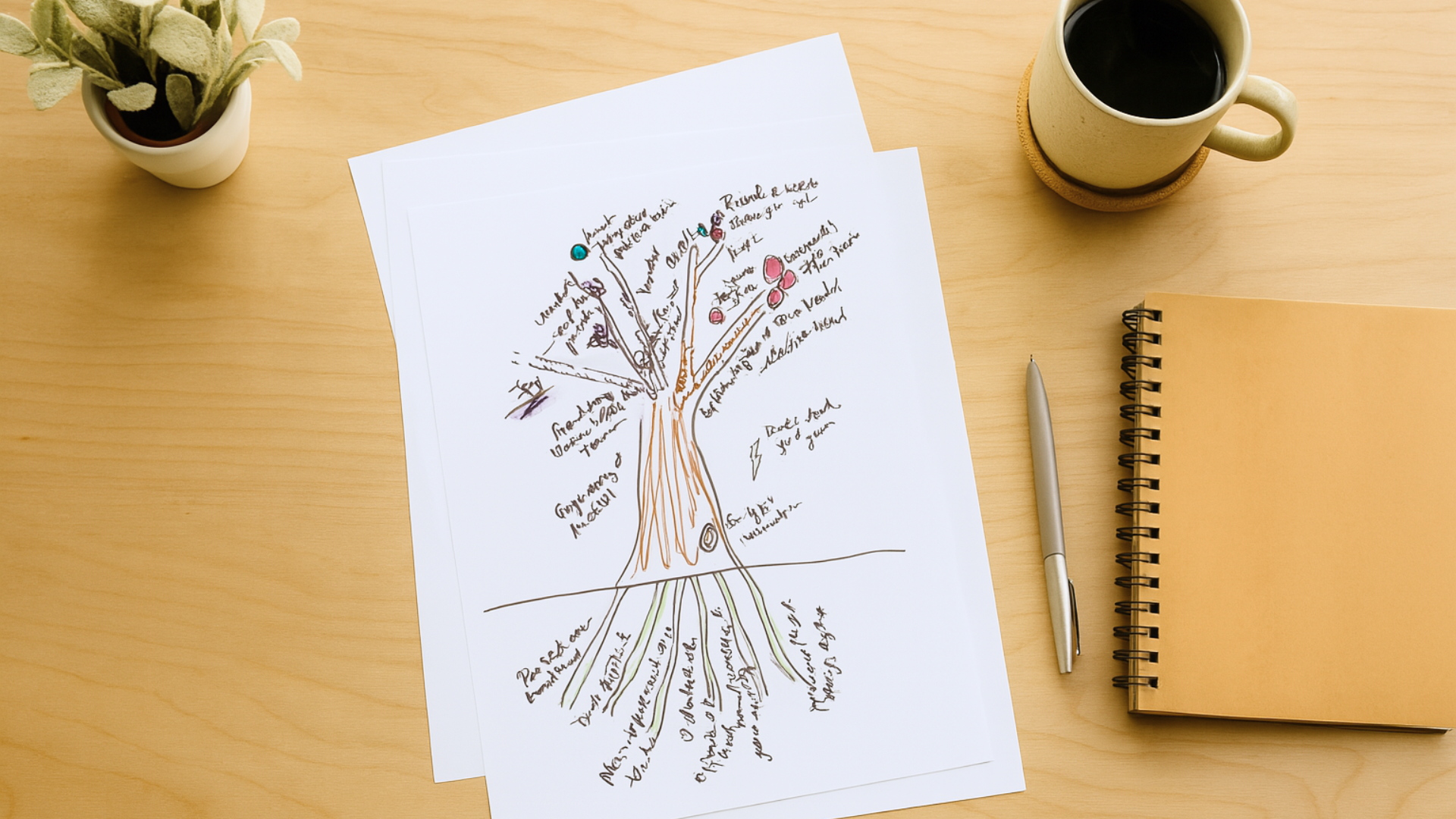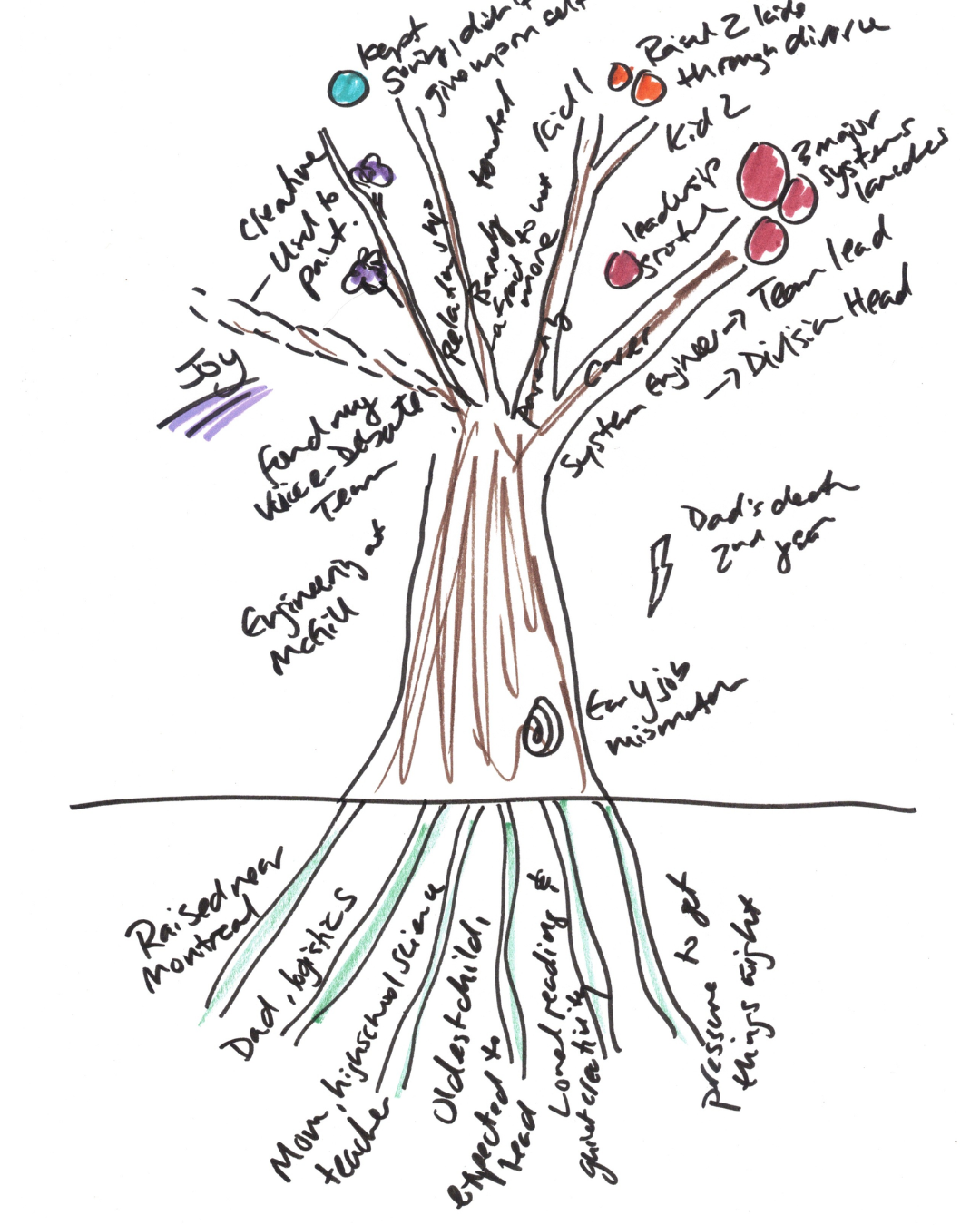How the Tree of Life Drawing Helped Clarify One Woman’s Goals

When a new coaching client shows up unsure of what they want, it’s easy to default to questions like “What are your goals?” or “Where do you want to be in six months?” These questions can be helpful, but they also assume the client is ready to name something clear and forward-facing. Often, especially in cases of burnout or transition, they’re not.
That’s why I reached for the Tree of Life.
Marie is a senior systems analyst working in biomedical tech. Smart, competent, and often relied on, she had recently been promoted to a leadership role. On paper, it looked like a win. But during our first session, she admitted she felt unsure—not just about the job, but about herself. The excitement had faded. She described her days as “automatic.” What brought her to coaching was a quiet worry she couldn't name, and a bigger question she hadn’t said out loud: What do I even want now?
Instead of starting with a checklist or timeline, we started with a drawing.
Why Drawing Works in Coaching
Visual tools like the Tree of Life don’t require artistic skill. They offer clients a structured, gentle way to reflect on their past, connect to their inner resources, and become more aware of the path they’ve taken. When someone is overwhelmed, anxious, or stuck in analysis, drawing slows the pace. It makes space for noticing, without pressure to fix.
The Tree of Life in particular works well for clients who are high-achieving but emotionally disconnected from their accomplishments. It helps surface strength, self-compassion, and clarity—without pushing them to be more productive. For women in STEM, who often operate under invisible expectations to perform and persist, this tool can be a surprising invitation to pause and honour what’s already there.
Four Layers of Growth
The Tree of Life has four parts: roots, trunk, branches, and fruits. Each layer offers an entry point into the client’s story.
1. The Roots
We began by drawing a simple line to represent the ground. Beneath it, Marie added her roots: her childhood in a small town near Montreal, her parents’ emphasis on education, and the quiet joy she found in reading and building things alone. One root, labelled “Mom—support + expectations,” stretched further than the others. Another was labelled “pressure to get things right.” These weren’t just memories. They were insights into how Marie had learned to show up in the world.
As she drew, her voice softened. “I forget how much of me was already here when I was a kid,” she said.
2. The Trunk
The trunk represents the years of growth from school through early adulthood. For Marie, this included earning her engineering degree, navigating the sudden loss of her father in university, and taking a mismatched job that taught her more than she expected. She drew her trunk tall and slightly bent forward. “It’s like I was always pushing, but maybe not totally balanced.”
We talked about what had helped her grow, and what had shaped her sense of resilience. She remembered an engineering professor who had encouraged her to pursue research. “That comment stayed with me,” she said. “I didn’t follow it exactly, but it reminded me that I had something to offer.”
3. The Branches
As Marie moved into the upper part of the tree, the branches took shape quickly: a strong one for her career, a delicate one for creative expression, two twigs for her children, and a barely visible one for romantic relationships. “I don’t think I’ve really let myself want more in that area,” she said. “It’s been easier to stay focused on work and parenting.”
This part of the drawing helped surface not only what had grown, but what had been pruned, neglected, or deferred. The creative branch, labelled “used to paint,” was especially faint. “I miss this part of me,” she said quietly.
4. The Fruits
Finally, she added her fruits: three major system launches, raising her children through a difficult divorce, and a leadership transition that still felt tender. Some fruits were fully drawn, others left in outline. One, labelled “joy,” was sketched with a question mark.
What surprised her most, she said, was the number of fruits she had already gathered. “I always feel like I’m behind,” she said. “But this makes me realize how much I’ve already done. Not just professionally, but personally too.”

The Power of Seeing It All Together
When the drawing was complete, I asked her to sit back and take it in. She stared at the page for a moment, then said, “It feels like a full life. Imperfect, but alive.”
That’s the moment I look for in this kind of session. Not the clarity of a to-do list, but the quiet recognition of something deeper. When clients see their own complexity visualised, they reconnect with a sense of wholeness. And from there, goal-setting becomes less about fixing and more about growing.
Marie didn’t walk away with a six-month action plan. But she left that session with something better: a felt sense of who she was, what mattered to her, and what she might want to nourish next. She decided to sign up for a weekly painting class. She also began tracking moments of joy—not because she had to, but because she wanted to grow that missing branch.
Drawing as a Coaching Tool
You don’t have to be a coach who uses creative methods all the time to benefit from tools like this. The Tree of Life works especially well when:
- A client feels lost, stuck, or overwhelmed
- There’s emotional weight or burnout in the room
- The client has trouble articulating their desires
- You want to establish trust before moving into action
It’s not about art. It’s about reflection, connection, and honouring what’s already within.
For clients like Marie, who are used to solving problems but not always used to being seen, drawing offers something rare: space to remember themselves.
Curious to try it?
The Tree of Life is one of several visual tools I use in my coaching practice. If you're feeling unsure about your direction, or just want to reconnect with your inner voice, this kind of gentle creative reflection can help.
You can join the 5-Day Creative Reset Challenge for more tools like this—or sign up for 👇The Creative Shift for weekly tips and reflections.